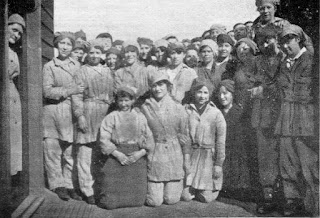 |
| Georgetown munition workers take a break for a snapshot |
This week I received a delightful letter which was written in 1917 by a girl who worked in a Scottish munitions factory during the Great War. She was replying to a soldier in France who had got in touch after discovering a note from her in a box of shells she had packed. 'Munitionettes', as they were known, often tucked away notes to bring a smile to the faces of soldiers in the trenches.
There is plenty of interest in the letter, which was passed on to me by the soldier's daughter-in-law. There is also a little sadness and some nice humour too, all of which will be revealed in my book so I won't give any more away here!
It was interesting, though, to discover more about where the young lady worked. Her letter mentions 'Houston', west of Glasgow, but there is no record of a munitions factory ever having been there. It's likely she worked a short distance away at Filling Factory No 4, as it was officially called.
The site consisted of a shell-filling plant, a railway station and a 'township' of wooden huts to house the (mainly women) workers. It was later renamed Georgetown after a visit in 1915 by David Lloyd George who was then Minister of Munitions and later Prime Minister
At its peak, between December 1916 and August 1917, some 12,000 people were employed there filling shells with explosives to be shipped off to France. Georgetown did not manufacture its own explosives so these materials were delivered by rail, along with shell cases to be filled.
The factory had a lively social life with its own magazine, the Georgetown Gazette, which published the above photo of its workers. It closed in 1919 and today there is nothing left except the Georgetown Road which still runs past the site.
 |
| At work inside a Government WW1 shell-filling plant |
No comments:
Post a Comment